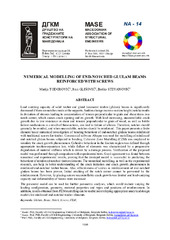Приказ основних података о документу
Numerical modelling of end-notched glulam beams reinforced with screws
| dc.creator | Todorović, Marija | |
| dc.creator | Glišović, Ivan | |
| dc.creator | Stevanović, Boško | |
| dc.date.accessioned | 2023-09-26T10:31:38Z | |
| dc.date.available | 2023-09-26T10:31:38Z | |
| dc.date.issued | 2019 | |
| dc.identifier.uri | https://grafar.grf.bg.ac.rs/handle/123456789/3163 | |
| dc.description.abstract | Load carrying capacity of solid timber and glued laminated timber (glulam) beams is significantly decreased if there are notches made at the supports. Sudden change in cross-section height (notch) results in deviation of stresses leading to concentration of tension perpendicular to grain and shear stress in a notch corner, which causes crack opening and its growth. With load increasing, uncontrollable crack growth due to low resistance in shear and tension perpendicular to grain of wood, as well as brittle failure mechanisms as a result of these actions, can lead to failure of a beam. Therefore, notches should generally be avoided, and when unavoidable, notches should be reinforced. This paper presents a finite element based numerical investigation of bending behaviour of end-notched glulam beams reinforced with traditional screws for timber. Commercial software Abaqus was used for modelling of reinforced end-notched glulam beams subjected to bending. Cohesive Zone Modelling (CZM) was employed to simulate the crack growth phenomenon. Cohesive behaviour in the fracture region was defined through appropriate traction-separation law, while failure of elements was characterized by a progressive degradation of material stiffness which is driven by a damage process. Verification of the proposed model was performed through comparison with experimental tests. Good agreement was found between numerical and experimental results, proving that the developed model is successful in predicting the behaviour of reinforced notched timber elements. The numerical modelling, as well as the experimental research, can help in better understanding of the crack initiation and crack growth phenomenon in reinforced end-notched timber beams. Also, effectiveness of screws as reinforcement od end-notched glulam beams has been proven. Initial cracking of the notch corner cannot be prevented by the reinforcement. However, by placing screws uncontrollable crack growth was limited and load-carrying capacity and deformability of beams were increased. The presented model can be used for further parametric analyses, which would include varying the loading configuration, geometry, material properties and types and positions of reinforcement. In addition, results obtained from FEM modelling can be useful in developing appropriate analytical design models for reinforced end-notched timber elements. | sr |
| dc.language.iso | en | sr |
| dc.publisher | MASE - Macedonian Association of Structural Engineers | sr |
| dc.rights | openAccess | sr |
| dc.rights.uri | https://creativecommons.org/licenses/by-nc-nd/4.0/ | |
| dc.source | Proceedings from the 18th International Symposium of MASE | sr |
| dc.subject | Glulam | sr |
| dc.subject | Beam | sr |
| dc.subject | Notch | sr |
| dc.subject | Screws | sr |
| dc.subject | FEM | sr |
| dc.title | Numerical modelling of end-notched glulam beams reinforced with screws | sr |
| dc.type | conferenceObject | sr |
| dc.rights.license | BY-NC-ND | sr |
| dc.identifier.fulltext | http://grafar.grf.bg.ac.rs/bitstream/id/11952/bitstream_11952.pdf | |
| dc.identifier.rcub | https://hdl.handle.net/21.15107/rcub_grafar_3163 | |
| dc.type.version | publishedVersion | sr |

